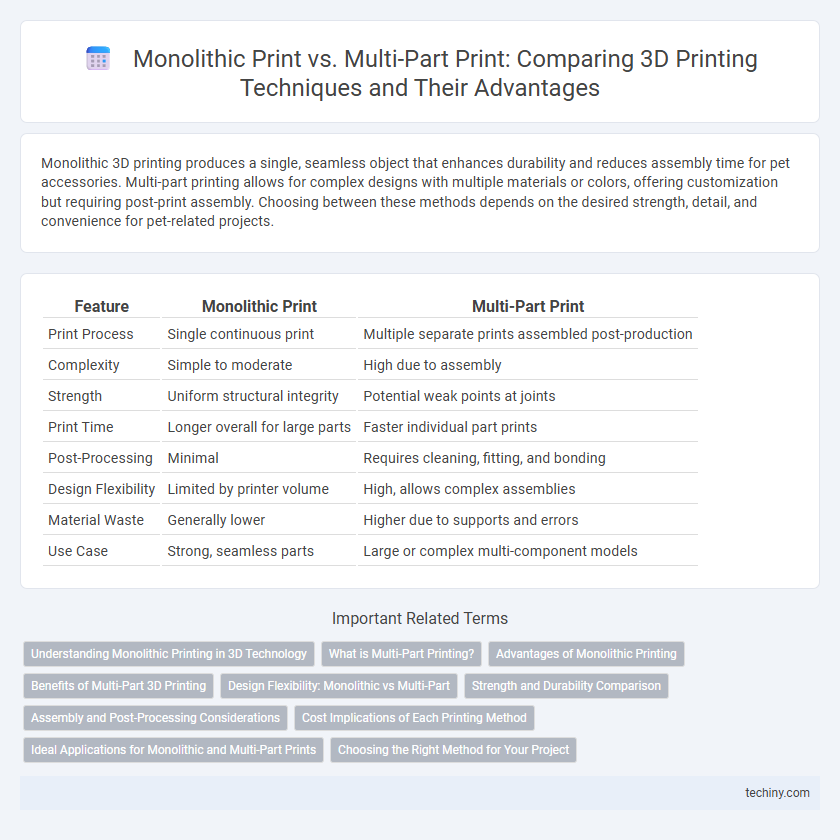Monolithic 3D printing produces a single, seamless object that enhances durability and reduces assembly time for pet accessories. Multi-part printing allows for complex designs with multiple materials or colors, offering customization but requiring post-print assembly. Choosing between these methods depends on the desired strength, detail, and convenience for pet-related projects.
Table of Comparison
| Feature | Monolithic Print | Multi-Part Print |
|---|---|---|
| Print Process | Single continuous print | Multiple separate prints assembled post-production |
| Complexity | Simple to moderate | High due to assembly |
| Strength | Uniform structural integrity | Potential weak points at joints |
| Print Time | Longer overall for large parts | Faster individual part prints |
| Post-Processing | Minimal | Requires cleaning, fitting, and bonding |
| Design Flexibility | Limited by printer volume | High, allows complex assemblies |
| Material Waste | Generally lower | Higher due to supports and errors |
| Use Case | Strong, seamless parts | Large or complex multi-component models |
Understanding Monolithic Printing in 3D Technology
Monolithic printing in 3D technology involves fabricating an entire object as a single, unified piece, enhancing structural integrity and eliminating the need for assembly. This approach optimizes material usage and reduces the risk of weak points associated with joints found in multi-part prints. Advanced slicing software and high-precision printers enable detailed monolithic designs, supporting complex geometries and improving overall durability.
What is Multi-Part Printing?
Multi-part printing involves creating an object by separately printing multiple components that are later assembled into a final product. This technique allows for greater complexity, improved print quality, and scalability by breaking down intricate designs that exceed the printer's build volume. It also facilitates easier post-processing, reduces print failures, and enables the use of different materials or colors for each part.
Advantages of Monolithic Printing
Monolithic printing offers superior structural integrity by eliminating weak points typically found at joints in multi-part prints, resulting in enhanced durability and strength. This approach reduces post-processing time and labor since the entire object is created in a single build without the need for assembly. It also minimizes potential alignment errors and material waste, optimizing overall production efficiency in 3D printing workflows.
Benefits of Multi-Part 3D Printing
Multi-part 3D printing enhances design flexibility by allowing complex geometries that are unachievable with monolithic prints, reducing the risk of print failure and enabling easier post-processing. It improves scalability through modular assembly, facilitating repairs, replacements, and customization without reprinting entire objects. This approach also optimizes material usage and print times by breaking down large models into smaller, more manageable components.
Design Flexibility: Monolithic vs Multi-Part
Monolithic prints offer limited design flexibility due to their single-piece construction, restricting complex internal geometries and post-processing options. Multi-part prints enable greater design freedom by allowing separate components to be optimized individually for strength, material properties, and surface finish. This segmentation facilitates intricate assemblies, easier repairs, and customization compared to monolithic manufacturing.
Strength and Durability Comparison
Monolithic 3D prints exhibit superior strength and durability due to their continuous, unbroken structure, minimizing weak points that typically occur at joints or seams in multi-part prints. Multi-part prints often require adhesives or mechanical fasteners, which can compromise overall integrity and reduce load-bearing capacity. The homogeneous material distribution in monolithic prints ensures better resistance to stress, impact, and fatigue, making them preferable for functional and structural applications.
Assembly and Post-Processing Considerations
Monolithic prints eliminate assembly steps, reducing alignment errors and improving structural integrity, while multi-part prints require precise joining techniques and adhesives that can impact durability. Post-processing for monolithic prints is streamlined, often limited to surface finishing, whereas multi-part prints involve additional labor for sanding and cleaning connection points. Choosing monolithic printing can significantly decrease overall production time and potential failure points, especially in complex geometries.
Cost Implications of Each Printing Method
Monolithic 3D printing typically incurs higher upfront costs due to longer printing times and increased material usage but reduces post-processing expenses by minimizing assembly labor. Multi-part printing lowers initial print time and material waste, yet often leads to elevated costs in assembly, joining techniques, and potential print failures during part integration. Evaluating total cost-effectiveness depends on project complexity, desired precision, and the balance between production speed and labor investment.
Ideal Applications for Monolithic and Multi-Part Prints
Monolithic prints are ideal for applications requiring high structural integrity, such as aerospace components and functional prototypes where strength and durability are critical. Multi-part prints are best suited for complex geometries, large-scale models, or objects with intricate internal features that exceed printer build volume or require post-assembly customization, like automotive parts and detailed architectural models. Choosing between monolithic and multi-part printing depends on the balance between mechanical performance, design complexity, and manufacturing constraints.
Choosing the Right Method for Your Project
Selecting between monolithic print and multi-part print depends on project complexity, material usage, and post-processing requirements; monolithic prints offer seamless strength and reduced assembly but may pose challenges in size and support removal. Multi-part prints provide design flexibility, easier printing of intricate components, and simplified maintenance or replacement, though they require precise alignment and bonding. Evaluating factors such as print volume limits, mechanical stress, and functional integration guides optimal method choice for efficient 3D printing outcomes.
Monolithic Print vs Multi-Part Print Infographic

 techiny.com
techiny.com